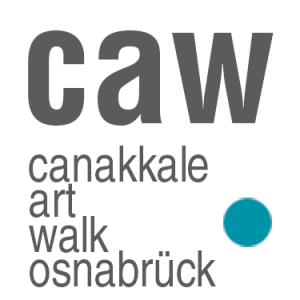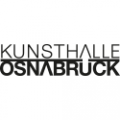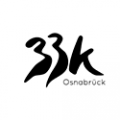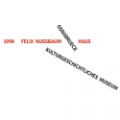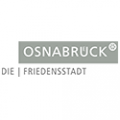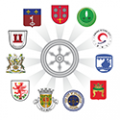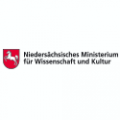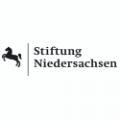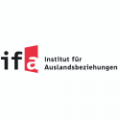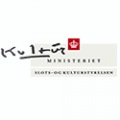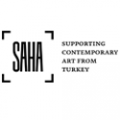Viron Erol Vert
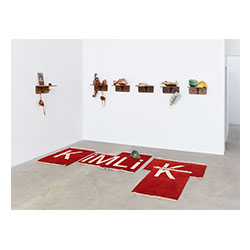
Die Diele
im Kunstquartier des BBK
Viron Erol Vert born (*1975) in Germany, lives and currently works between Istanbul and Berlin.
He is strongly influenced by his multicultural background that arches between Orient and Occident.
This cultural matrix is one of the reasons that leads him to question identity and affinity which are the central subjects in his artistic work.
Vert analyses human kind regarding social and cultural topics in society.
He is interested in the contrasts evolving from the results of combining antagonizing elements.
By confronting mythological as well as figurative elements with issues of the present, he is searching for new realities.
His choice of media is related to the topic at hand and involves a wide range from sculpture and collage over painting on paper and canvas to print on fabric and sound.
The diversity of his work is mirrored in his artistic expression and his unique way of selecting and combining unusual materials reflects his contentual artistic aspects. ‚
The collision of all those aspects allows Vert to override fixed positions and to look for new solutions in form and content.
Vert studied at the UdK in Berlin and the Department for Visual Art at the Royal Academy in Antwerp.
He has graduated with mentionable honor his master class in Fashion design at the HTW, Berlin and at the Department for Experimental Surface at the KHB in Berlin. From 2004 on he participated in several exhibitions in the national and international field.
Vert presented his works at “Enough Room for Space“, Gent; “Centro Cultural Montehermoso,Vitoria-Gasteiz”, Spain; “Gallery Opendahl”, Berlin;
“Colette“, Paris; “Die ungarische Methode”, Ascherleben; “Galerie Reinhard Hauff”, Stuttgart; “Fellethuset”, Berlin; “Berghain“, Berlin and “Galerist“, Istanbul.
Besides his solo work he collaborated in several projects with different artists like in “13 Monde“, with Sven Marquardt; “Echoes from Mamori” with Olof Dreijer and “Messenger” with Luke Slater.
In 2008 Viron Erol Vert won the first prize in the category Painting and Illustration, of the turkish Society for Sculpting and Arts awarded by Aksanat, Istanbul.
Viron Erol Vert born (*1975) in Germany, lives and currently works between Istanbul and Berlin.
He is strongly influenced by his multicultural background that arches between Orient and Occident.
This cultural matrix is one of the reasons that leads him to question identity and affinity which are the central subjects in his artistic work.
Vert analyses human kind regarding social and cultural topics in society.
He is interested in the contrasts evolving from the results of combining antagonizing elements.
By confronting mythological as well as figurative elements with issues of the present, he is searching for new realities.
His choice of media is related to the topic at hand and involves a wide range from sculpture and collage over painting on paper and canvas to print on fabric and sound.
The diversity of his work is mirrored in his artistic expression and his unique way of selecting and combining unusual materials reflects his contentual artistic aspects. ‚
The collision of all those aspects allows Vert to override fixed positions and to look for new solutions in form and content.
Vert studied at the UdK in Berlin and the Department for Visual Art at the Royal Academy in Antwerp.
He has graduated with mentionable honor his master class in Fashion design at the HTW, Berlin and at the Department for Experimental Surface at the KHB in Berlin. From 2004 on he participated in several exhibitions in the national and international field.
Vert presented his works at “Enough Room for Space“, Gent; “Centro Cultural Montehermoso,Vitoria-Gasteiz”, Spain; “Gallery Opendahl”, Berlin;
“Colette“, Paris; “Die ungarische Methode”, Ascherleben; “Galerie Reinhard Hauff”, Stuttgart; “Fellethuset”, Berlin; “Berghain“, Berlin and “Galerist“, Istanbul.
Besides his solo work he collaborated in several projects with different artists like in “13 Monde“, with Sven Marquardt; “Echoes from Mamori” with Olof Dreijer and “Messenger” with Luke Slater.
In 2008 Viron Erol Vert won the first prize in the category Painting and Illustration, of the turkish Society for Sculpting and Arts awarded by Aksanat, Istanbul.
In “Die Diele” (The foyer), Viron Erol Vert addresses current social situation and political resistance in Istanbul.
The reference to the protest against the state, symbolized with a series of homemade objects developed by citizens as protections in demonstrations, is both a commentary and a wider reference to the suppression of national and religious minorities, which has been affecting his family’s history.
Self-made gas masks, kitchen spray bottles containing mixtures to mitigate the effects of tear gas, improvised helmets are places on iconic foyer elements and next to objects that bring us into the realm of the domestic.
By doing so Vert elevates the objects of resistance to cultural items, elements which are increasingly defining the identity of our lives.
An idea which he strengthens further by spreading in front of them traditionally knitted carpets in which the word “Kimlik” is spelled. Meaning Identity and being a short-form of ID-card the installation assumes also the role of a direct question to the viewers’ production of their own identity and their relation with state structures.
In “Die Diele” (The foyer), Viron Erol Vert addresses current social situation and political resistance in Istanbul.
The reference to the protest against the state, symbolized with a series of homemade objects developed by citizens as protections in demonstrations, is both a commentary and a wider reference to the suppression of national and religious minorities, which has been affecting his family’s history.
Self-made gas masks, kitchen spray bottles containing mixtures to mitigate the effects of tear gas, improvised helmets are places on iconic foyer elements and next to objects that bring us into the realm of the domestic.
By doing so Vert elevates the objects of resistance to cultural items, elements which are increasingly defining the identity of our lives.
An idea which he strengthens further by spreading in front of them traditionally knitted carpets in which the word “Kimlik” is spelled. Meaning Identity and being a short-form of ID-card the installation assumes also the role of a direct question to the viewers’ production of their own identity and their relation with state structures.
